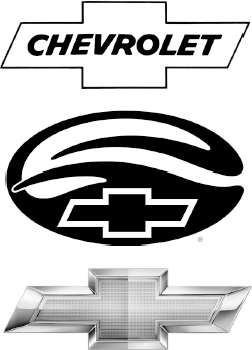These versions of Chevrolets bowtie from 1960 to 2012 illustrate aspects of Chevrolet history in that period. At top, a 1960-era bowtie, with Chevrolet spelled out, shows little change from the logo established by founder William C. Durant in 1914. In the middle, the bowtie is nearly invisible on a 1999 Chevrolet Malibu, when marketing was in turmoil. The bowtie at bottom is the contemporary nameless version for global vehicles. (G.)
Michael W. R. Davis
Copyright 2012 by Michael W. R. Davis
ACKNOWLEDGMENTS
As with a number of my past Arcadia Publishing photographic histories, the National Automotive History Collection (N in image credits) at the Detroit Public Library has been a major source of images for this history of Chevrolet. I am indebted to the following staff members of the library for their assistance: Mark Bowden, Dawn Eurich, Paige Plante, Carrie Pruett, and Robert Tate. Once again, Larry Kinsel of GM Media Archives (G) has been patient and accommodating in his assistance with GM images.
Others who helped along the way include fellow automotive historians Terry Boyce and Jerry Burton (whose 100 Years of Chevrolet, coauthored with Ralph Kramer, is a collectors gem), GM engineering manager and historian Kevin Kirbitz, fellow journalist Ken Zino, fellow author Larry Gustin, and automotive data expert Tom Libby, as well as GM staff experts Christo Datini, Scott Settlemire, and Tom Wilkinson. A D indicates my own imageseither from my camera or my personal collection, including some images from various sources that were keyed in my previous Arcadia automotive histories.
As usual, my wife Karen bore up without much companionship from me during the intensive creation of this volume, and for its completion, I am grateful for her patience and excellent copyediting skills.
BIBLIOGRAPHY
Automotive News, the 100-year Almanac. Detroit, MI: Crain Publishing, 1996.
Binder, Alan, ed. Wards Automotive Yearbooks, 20002011. Southfield, MI: Wards Communications.
Burton, Jerry and Ralph Kramer. 100 Years of Chevrolet. New Albany, IN: Automobile Quarterly Publications, 2011.
Standard Catalogue of American Cars, 19461975. First Edition. Iola, WI: Krause Publications, 1987.
Standard Catalogue of American Light-Duty Trucks, 18962000. First Edition. Iola, WI: Krause Publications, 2001.
Standard Catalogue of Imported Cars, 19462002. Second Edition. Iola, WI: Krause Publications, 2002.
INTRODUCTION
Chevrolets second 50 years began with the start of the 1960s. A few months before, in October 1959, Chevrolet introduced as a 1960 model the radical, rear-engined Corvair, a symbol of the forthcoming plunge into product proliferation that the domestic auto industry experienced in the 1960s.
The importance of product proliferation was that there no longer would be just one high-volume Chevrolet car in the marketplace. By the end of the decade, in 1969, Chevrolet Division of General Motors would be marketing six distinctive Chevrolet passenger cars: the big, or standard, Chevrolet; the radical Corvair (soon to be withdrawn, its replacement Vega not yet ready); the compact Chevy II (1962); the midsized Chevelle (1964); the sporty Camaro (1967); and, of course, the unique high-performance Corvette sports car, which was originally introduced as a separate brand in 1953 but did not reach volume production until the following decade. Each of these Chevys presented different sizes and chassis designs (platforms or architecture in recent terminology), requiring large investments. While altogether the volumes thus achieved exceeded those of earlier years, the associated costs could not be covered by the revenues previously generated by just one Chevrolet. And eventually, Chevrolets volume leadership was eroded by domestic and foreign-brand competition.
The 1960s also were marked by a number of other industry-shaking trends that continued into the 2000s. Onset of federal regulation of various aspects of the auto industry was foremost, initiated with window price stickers stipulated by the Mulroney Act of 1958. Then came California regulations of automobile engine pollutants beginning in 1961, federal regulations of vehicle safety in 1967, and the Federal Environmental Protection Agency authorization of 1969. These impositions of outside control were onerous for the domestic auto industry, especially market leader Chevrolet, which, in preceding decades, had basked in the glory of contributing to the nations economy and helping win World War II with the Arsenal of Democracy. Some of the restrictions represented superior advocacy and lobbying ability by traditional industry adversaries, including dealers, auto insurance companies, and trial lawyers.
In between, especially as it concerned Chevrolet, were strong rumors circulating in Detroit in the early 1960s that federal antitrust activity would be aimed at forcing General Motors to divest Chevrolet Division and make it a separate companyas it had been before 1918. This never happened, and whether the rumor had a basis in fact is unknown, but it affected Detroit thinking at the time.
The 1960s for Detroit also meant the rise of trucks, previously used mostly for work, into recreational vehicles and family transportation. Eventually, more trucksto include passenger vans, minivans, sports utility vehicles (SUVs), crossover utility vehicles (CUVs), and other variantsthan cars would be sold in the American market. In 2012, Chevrolet was marketing eight different car-like vehicles and nine different truck-like vehicles in the United States. Chevy sold 975,617 trucks in 2011, compared to only 800,185 cars. However, the definitions ofand differences betweencars and trucks had become blurred by both marketing and applicable federal regulation classifications.
Finally, the die was cast in the 1960s for the globalization of the auto industry, beginning with a rising proportion of import-brand vehicles in the United States, led by Volkswagen of Germany, resulting in both foreign manufacturers dominating the US market by the 1990s and domestic manufacturers producing global, or world car, designs rather than selling only familiar American vehicles in foreign markets as they had done in previous decades.
The entire history of Chevrolet has been characterized by intense competition with crosstown rival Ford. This was especially true during the product proliferation of the 1960s, where a new offering by one brand triggered a competitive response by the other. Generally, upstart Ford, seeking to regain the market leadership it had held before the rise of Chevrolet in the 1920s, instigated those exchanges. Through those years, Chevrolet correctly maintained that it was still selling more of its big, or full-size, car than Ford was with its matching full-size product. Through this, the customers benefited with a greater choice of car sizes and design features.












